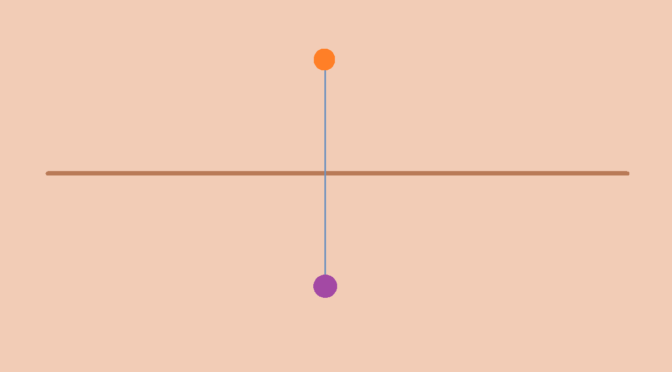Let’s introduce and describe some properties of the line with two origins.
Let \(X\) be the union of the set \(\mathbb R \setminus \{0\}\) and the two-point set \(\{p,q\}\). The line with two origins is the set \(X\) topologized by taking as base the collection \(\mathcal B\) of all open intervals in \(\mathbb R\) that do not contain \(0\), along with all sets of the form \((-a,0) \cup \{p\} \cup (0,a)\) and all sets of the form \((-a,0) \cup \{q\} \cup (0,a)\), for \(a > 0\).
\(\mathcal B\) is a base for a topology \(\mathcal T\) of \(X\)
Indeed, one can verify that the elements of \(\mathcal B\) cover \(X\) as \[
X = \left( \bigcup_{a > 0} (-a,0) \cup \{p\} \cup (0,a) \right) \cup \left( \bigcup_{a > 0} (-a,0) \cup \{q\} \cup (0,a) \right)\] and that the intersection of two elements of \(\mathcal B\) is the union of elements of \(\mathcal B\) (verification left to the reader).
Each of the spaces \(X \setminus \{p\}\) and \(X \setminus \{q\}\) is homeomorphic to \(\mathbb R\)
Let’s prove it for \(X \setminus \{p\}\). The map \[
\begin{array}{l|rcll}
f : & X \setminus \{p\} & \longrightarrow & \mathbb R \\
& x & \longmapsto & x & \text{for } x \neq q\\
& q & \longmapsto & 0 \end{array}\] is a bijection. \(f\) is continuous as the inverse image of an open interval \(I\) of \(\mathbb R\) is an open subset of \(X\). For example taking \(I=(-b,c)\) with \(0 < b < c\), we have
\begin{align*}
f^{-1}[I] &= (-b,0) \cup \{q\} \cup (0,c)\\
&= \left( (-b,0) \cup \{q\} \cup (0,b) \right) \cup (b/2,c)
\end{align*}
One can also prove that \(f^{-1}\) is continuous.
\(X\) is not Hausdorff
If \(X\) was a Hausdorff space, there would exist disjoint open subsets \(U, V\) containing respectively \(p\) and \(q\). Hence there would exist positive reals \(a,b\) such that \((-a,0) \cup \{p\} \cup (0,a)\) and \((-b,0) \cup \{q\} \cup (0,b)\) are disjoint. Which is absurd.
\(X\) satisfies all the conditions for a manifold except for the Hausdorff condition
Indeed, we have proven that \(X\) is a topological space and that each point is locally homeomorphic to \(\mathbb R\). One can also verify that \(X\) is second countable as all open intervals in \(\mathbb R\) having rational endpoints that do not contain \(0\), along with all sets of the form \((-a,0) \cup \{p\} \cup (0,a)\) and all sets of the form \((-a,0) \cup \{q\} \cup (0,a)\), for \(a > 0\) rational, form a base of the topology of \(X\).


2 thoughts on “The line with two origins”